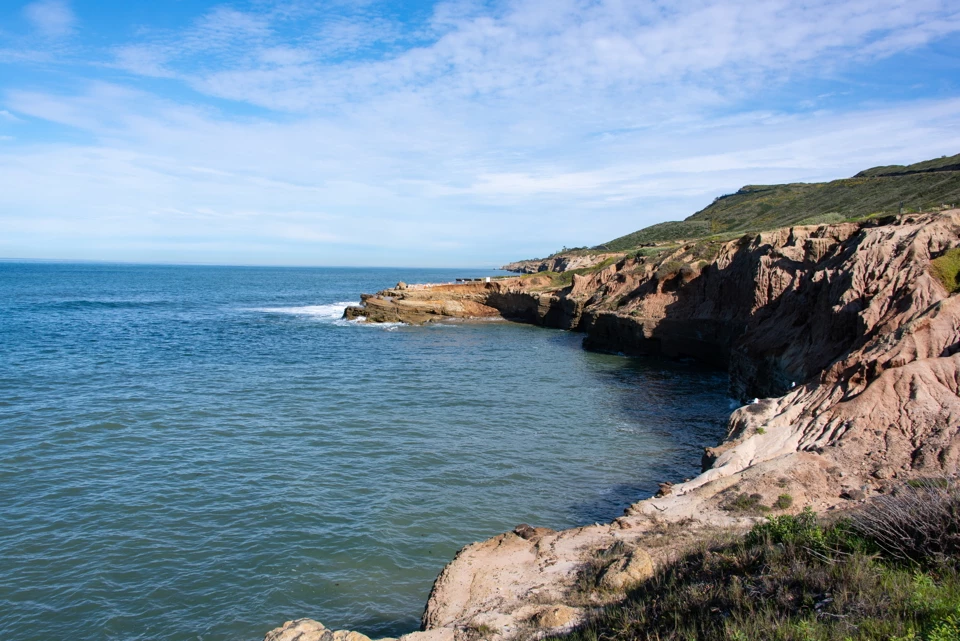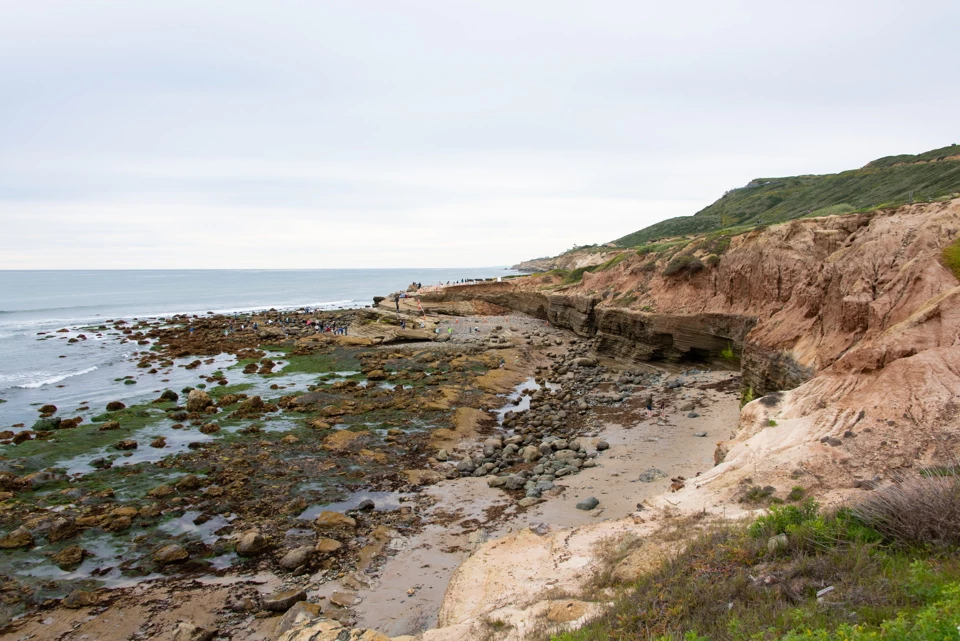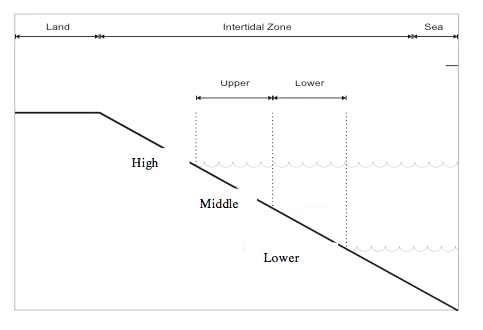
NPS Photo Visiting the Tidepools at Cabrillo National MonumentThe rocky intertidal area, also known as the tidepools, is a popular attraction at Cabrillo National Monument, drawing over 350,000 visitors annually. It is one of the best-protected rocky intertidal zones in California. The ideal time to visit the tidepools is during the fall and winter months when low tides coincide with park hours. In spring and summer, the tide often covers the tidepools during open hours. Important Information Before Your VisitPlease review the following resources to ensure a safe and enjoyable experience at the tidepools: 
NPS photo. The Wonders of TidepoolsTidepools are captivating natural formations found along rocky coastlines. These depressions in the rocks have been created over millions of years through a combination of biological, physical, and chemical processes. How Tidepools FormTidepools require a rocky coastline to form. The process starts with the constant ebb and flow of the tide. As the tide shifts from high to low, pools of seawater are left behind among the rocks, creating tidepools. Life in a TidepoolWhen the tide recedes during low tide, water remains trapped in these tidepools, forming a unique and diverse habitat. Marine creatures such as starfish, sea anemones, crabs, and small fish find themselves in these isolated pools. These critters must adapt to changing conditions, such as fluctuations in temperature, salinity, and oxygen levels, making tidepools an excellent place to observe resilient marine life up close. Why Tidepools MatterTidepools are not only fascinating to explore but also play a crucial role in the coastal ecosystem. They provide a habitat for a variety of species, some of which are specially adapted to survive in the challenging environment of the intertidal zone. Tidepools also offer scientists and educators a unique opportunity to study marine life and the effects of environmental changes on these delicate ecosystems. Exploring TidepoolsWhen visiting tidepools, it's important to tread carefully to avoid harming the fragile creatures and plants living there. Always watch where you step and never remove animals or plants from their natural habitat. By following these guidelines, you can help preserve these natural wonders for future generations to enjoy. Discover the hidden world within tidepools and gain a deeper appreciation for the intricate balance of nature at work along our coastlines. 
NPS photo. Prepare For Your VisitImportant Cell Phone Service InformationPlease be aware that cell phone service is not available at the tidepools. If you use a driver for hire for transportation, make arrangements to pick you up at a certain time and location. Otherwise, you will not be able to reach anyone, and you may have to hike up the Oceanside Trail to the top of the park. Road Closures:The road to the tidepools may be closed if the area hits capacity. The road to the tidepool area will be closed (usually for around 30 minutes) until sufficient capacity in the parking areas becomes available. This temporary closure allows for traffic to flow freely and enhances the visitor experience by reducing crowding and minimizing damage to the fragile ecosystem. Please plan your trips to allow for this delay, and thank you for your patience. Transportation:A vehicle is the best way to get to the lower area of the park where the tidepools are located; once parked, it's a short walk and scramble down into the tidepools. We discourage visitors from walking down Cabrillo Road for safety reasons. The road is narrow without shoulders and drivers may not see you. People may also use the Oceanside Trail to access the coastal area. Clothing and Footwear:Please plan for appropriate clothing and footwear. Shoes with good gripping soles are best, as rocky areas become slippery with water and algae. Closed-toe shoes are recommended. Sandals or flip-flops are strongly discouraged due to their inability to provide a good grip on the slippery rocks. Safety with Children:Please keep small children close. A child's enthusiasm and excitement over being in this natural wonderland can quickly translate into a slip or tumble. By following these guidelines, you can ensure a safe and enjoyable visit to the tidepools, while helping to protect this delicate and unique environment. Protecting the ResourcesTo ensure that current and future visitors can enjoy the healthy and diverse tidepools at Cabrillo National Monument, specific guidelines are necessary to minimize human impact on the organisms. The following guidelines have been established to protect tidepool inhabitants:
By following these guidelines, you can help maintain a healthy environment for marine life at Cabrillo National Monument, preserving this precious ecosystem for generations to come.
Visit our keyboard shortcuts docs for details
Want to make the best of your visit to the tidepools at Cabrillo National Monument? Check out these easy Dos and Don’ts from Ranger Carmen to help prepare you for your rocky intertidal explorations! High vs. Low Tide 

Left image
Right image
Visit our keyboard shortcuts docs for details
This is a time lapse video on January 31, 2022 at Cabrillo National Monument. High tide was 7.3ft at 8:00am and low tide was a -2.0 at 3:08pm. High tide is approximately 23 seconds into the video and the low tide occurs approximately at the 3 minute, 10 second time mark. The video was created with a GoPro Hero8 with a 5 second interval, over a period of 9 hours The speed is 150 times actual time. Visiting the Tidepools: Best Time and TipsBest Time to Visit:The best time to visit the tidepools at Cabrillo National Monument is during late fall and winter. Extreme low tides, which reveal the most marine life, occur during daylight hours in these seasons, making it ideal for observing tidepool creatures. Summer Visits:While summer visits are possible, the low tides generally occur at night, making it difficult to see marine life. However, the coastal area offers beautiful ocean views and blooming flowers along the Coastal Trail. Tidepool Timing:
Exploring Coastal Areas:Even if tidepool creatures are not visible in summer, the scenic ocean views and blooming flowers along the Coastal Trail make it worth exploring. Parking Tips:
General Rule:Visit tidepools approximately two hours before low tide (when the tide is receding) and two hours after low tide (when the tide is coming back in). Keep in mind that the tidepool area closes at 4:30 p.m. Tide Predictions for Scripps Institution of Oceanography PierPlease note that the following chart are predictions for the Scripps Pier in La Jolla. Tide predictions are based on the charts you are using. They should all be used as guidelines. Although these charts are for the Scripps Pier in La Jolla, there is only a slight difference for the times at Cabrillo. They are all predictions so you can consider the times shown in the charts and tables as accurate for Cabrillo. The low tide viewing window is an hour or more before and after the low tide time.
Tide TablesAt Cabrillo, a tide of 0.7 or lower provides the best opportunity to explore the tidepools. Each day, there are two high tides and two low tides. Use the tide chart to find the times of the high and low tides, ensuring your visit coincides with the optimal conditions for tidepool exploration. For the most accurate and up-to-date tide information, consult the tide tables available on the Cabrillo National Monument website or local tide prediction resources.
Virtual Visit to the TidepoolsTake a walk with us on a virtual visit to the tidepools at Cabrillo National Monument. Explore the diverse marine life and unique geological formations from the comfort of your home. This virtual tour allows you to experience the beauty and complexity of the tidepools, learn about the various zones, and observe the creatures that inhabit these areas. Whether you are planning a future visit or simply curious about the tidepools, this virtual tour offers an engaging and educational experience. 
NPS Photo Understanding Tidepool ZonesThe tidepool area at Cabrillo National Monument is divided into three distinct zones: High, Middle, and Low. Each zone hosts different types of animals and plants, each adapted to their specific conditions. The visibility of these zones varies with the tide height, with some zones becoming exposed only during low tides. High Zone: Located at the uppermost part, it receives occasional splashes from high tides. Here, you'll find barnacles, limpets, chitons, crabs, and mussels. Middle Zone: Situated between the high and low zones, this area is rich in marine life due to varying tides. It hosts anemones, keyhole limpets, Black tegula snails, Kellet’s whelks, Sandcastle worms, surf grass, and various algae like sponge weed, kelps, and red algae. Low Zone: Accessible only during the lowest tides, this zone is teeming with diverse marine life, including octopus, sea stars, nudibranchs, sea hares, spiny lobsters, urchins, and various types of fish. This makes it an exciting area for tidepool exploration, showcasing the rich biodiversity of the coastal ecosystem. 
NPS High ZoneThe high or splash zone is the uppermost part of the tidepools, where some animals survive with only occasional splashes from high tides. In this zone, you can find barnacles, limpets, chitons, crabs, and mussels. Look closely at the rocks; while some creatures may appear dead or like fossils, they are alive and enduring until the tide returns. Please avoid removing anything from the rocks, as this can disturb or harm the animals.
Middle ZoneThe middle zone, located between the high and low zones of the tidepools, is teeming with diverse marine life due to the varying tides. In this zone, you can encounter anemones, keyhole limpets, Black tegula snails, Kellet’s whelks, and Sandcastle worms. Additionally, surf grass, the only true plant in the tidepools, thrives here alongside various algae, including sponge weed, kelps, and red algae. The dynamic tidal activity in the middle zone creates an ideal habitat for a wide range of fascinating organisms. Low ZoneThe low zone is accessible only during the lowest tides and offers the chance to observe a variety of marine life. In this zone, you can find octopus, sea stars, nudibranchs, sea hares, spiny lobsters, urchins, and various types of fish. The rich diversity in the low zone makes it an exciting area for tidepool exploration. Other Tidepool Features and ResourcesThe tidepools are more than just the critters you can find in the water and between rocks. You can also learn about the geology that helped create the intertidal area that we see today. You can also learn about types of seaweeds, mammals, birds, plants, reptiles and the kelp forests that you might see along the Coastal trail. We encourage you to read about what to expect as well as the rules for exploring the tidepools before you visit. You can also access our Life in the Intertidal Zone and the Intertidal Field Guide. |
Last updated: December 31, 2025
